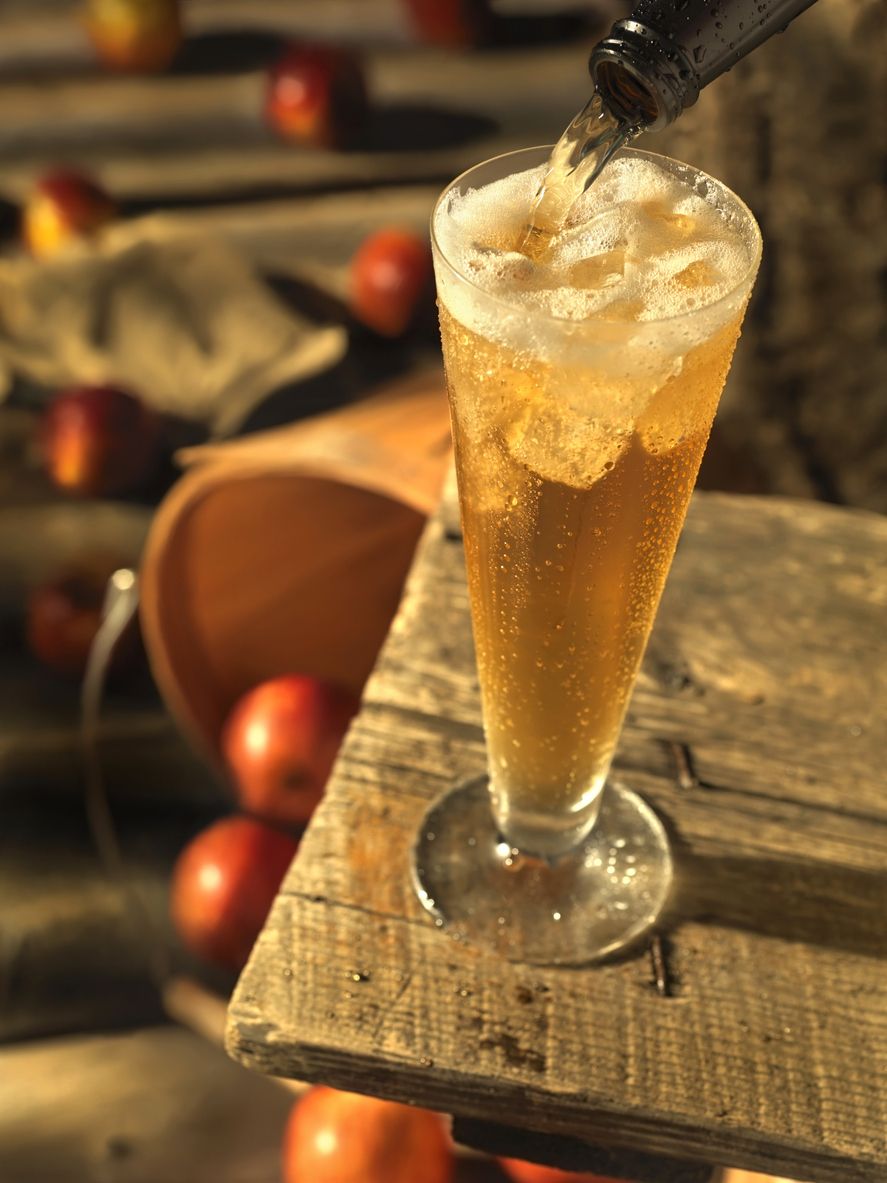Can you believe it’s August already?! As summer begins the inevitable crawl into autumn, we can begin to look forward to cooler weather, changing colors, and an absolute abundance of apples, particularly Gravensteins. In fact, these local heirlooms are one of the earlier apple varieties to be ready for harvest, and every year, they get welcomed in with quite the party – the annual Gravenstein Apple Fair! As always, Oliver’s is in the Sonoma County spirit and are proud to once again be sponsoring the cider tent at the fair. In keeping with this theme, we’ve decided to make ourselves the apple of everyone’s eye and take a cool 20% off all our hard ciders! But before we throw you into the wonderful land of ciders willy-nilly, let’s just break down what exactly makes a cider a cider and how you can pick the perfect cider to suit your tastes!
Ciders of all kinds have a long and storied past that spans continents and eons, but the reasons to drink them remain the same as it always has – they’re crisp, refreshing, and damn drinkable! They’re also gluten-free, but it seems doubtful that our cider forebears would have known about that. The process for creating a hard apple cider is really very straightforward, and it all starts right where you’d expect – with apples. Now, when choosing an apple to munch on, one normally looks for something with some sweetness and a good crunch, but that’s not necessarily so with ciders; depending on the cider being made, apples are chosen based on their tartness, their bitterness, and even their tannic qualities. When we think of tannins, usually the beverage that comes to mind is wine, but these funky little compounds are present throughout nature, and they have a major hand in developing a nuanced hard cider. Once the apples have been chosen, they are washed and ground into a mash known as pomace. It’s at this stage that different flavorings can be added, such as spices or other fruits. Eventually, the pomace is pressed to release the juice, which is collected into casks or vats for fermentation. Like beer, hard cider can thank various yeasts for all its delicious, fermented qualities. These can be natural strains of yeasts that already present in the fruits or they can be particular strains which are introduced after killing off the natural yeasts.
As the cider ferments, it must eventually be moved to a new fermentation vessel, which is done to allow brewers to discard yeast that is no longer active. This process, known as racking, is crucial to producing a cider that is clear in color and well flavored. Any air is removed to prevent contamination, and the cider is allowed to continue to ferment for anywhere from 3 months to 3 years, depending on the cider being made. Some ciders are allowed to ferment completely before bottling and do not feature the kind of effervescence present in beers or champagnes; still others are bottled at the right point in the process to capture the carbonation, and some may even be treated like champagne and have sugar added to the bottle itself. While this helps to encourage the presence of bubbles, if it’s not done correctly, it can turn your delicious beverage into quite the time bomb!
Different variations in this process, from what apples are used to how long it’s fermented, give individual ciders character and allow cideries to put their personal signature on their products. For instance, many Sonoma County cideries choose to brew with delicious Gravenstein apples, resulting in ciders that are unique to the qualities of those apples and the land that grew them. This lends itself to a truly massive array of cider options, which can be more than a little intimidating to a first-time cider-drinker. A helpful comparison can be made to white wine – like white wine, cider ranges from dry to off-dry to semi-dry and semi-sweet. Also like white wine, cider will not go bad if kept on the shelf, but it tends to taste and keep best in the refrigerator. If you tend to prefer a dry white wine, starting with a dry hard cider can be a good way of breaking into the cider game; on the other hand, if you’re looking for a less intense alternative to beers, an off-dry or semi-dry cider will lend a little more sweetness and lot of refreshing apple flavor. Hard ciders can also be made with all manner of fruits and fruit blends as well, examples of which include cherries, berries, citrus, and even pineapples.
Now that you’ve been primed and prepped for hard cider mastery, check out some of the hard ciders you’ll be able to find on sale in our stores!
Ace Joker
($4.39+CRV, 22 oz. Bottles)
First launched in 2008, the Joker has rapidly become Ace Cider’s second top seller. This cider is great for mixed drinks such as mimosas or chilled on its own. Its versatility pairs well with fish and cheeses.
AppleGarden Farm
($7.19+CRV, 500 ml. Bottles)
“Our farmstead artisan cider is made with all organic apples grown exclusively on our farm in Tomales; hand-picked and processed entirely on the premises. Enjoy with cheese, spicy charcuterie, and oysters!”
Ethic Gravenstein
($7.99+CRV, 500 ml. Bottles)
Sparking and fully dry, this cider is delicate and graceful with lively acidity. Notes of apricot and rose petal dance with refreshingly chalky minerality. An embodiment of peak summer love – Gravenstein season!
Goat Rock Gravenstein
($5.59+CRV, 22 oz. Bottles)
“We use organic apples grown in Sebastopol, and hand craft small batches of our amazing cider in Healdsburg.” For the Gravenstein Blend – Organic Sebastopol Gravenstein Apples. Yeast. Patience.
Perfection.
Golden State Hamaica
($2.79+CRV, 19.2 oz. Bottles)
Hamaica is made with 100% fresh pressed apples and Champagne yeast. Natural Hibiscus flowers provide tropical, fragrant aromas and tart berry flavors to this crushable pink cider.
Tilted Shed Graviva
($9.59+CRV, 500 ml. Bottles)
Pronounced “Gra-VEE-va” as in “Viva la Grav(enstein)!” Blend of 100% organic fresh-pressed Sonoma County heirloom and traditional cider apples.
Leaky Barrel Green and Gold
($15.99+CRV, 750 ml. Bottles)
Early Harvest Varietals: Rhode Island Greening and Jonagold and Late Harvest Varietals: Black Twig and Nehou Pippins. Made with 100% Sonoma County apples.
Samuel Smith’s Organic Cider
($3.59+CRV, 18 oz. Bottles)
A medium dry cider with brilliant straw colour, light body, clean apple flavour and a gentle apple blossom finish. Samuel Smith’s makes this cider at a small, independent British brewery, the oldest brewery in Yorkshire.
Clos Normand
($6.39+CRV, 750 ml. Bottles)
Pours a beautifully transparent golden amber color. Light aromas of tart apple cider. Well-balanced flavor of slightly tart and slightly sweet apple that leads into a dry finish. Enjoy!
Stem Off-Dry
($1.99+CRV, 12 oz. Bottles)
Instead of fermenting to complete dryness and back sweetening with juice to reach the ideal off-dry qualities, we halt fermentation at the precise moment just before all the natural sugar in the juice is fermented.
Angry Orchard Rosé
($7.19+CRV, 6 Pack/12 oz. Bottles)
Angry Orchard Rosé Cider is made with rare, red flesh apples from France. Each apple is crisp, juicy and red to the core, adding an irresistible rosy blush and apple-forward taste with a refreshing dry finish.
Crispin Original
($7.19+CRV, 6 Pack/12 oz. Bottles)
Crispin Original is crisp and refreshing, with fruit-forward green apple flavor and a subtle citrus aroma. Crisp green apple nose with clean bright citrus notes of lemon and lime.
Le Pere Jules
($3.99+CRV, 330 ml. Bottles)
Pours a hazy amber color with a thin ring of head. Aroma of dry apples, mild barnyard, hay, and vinous notes. The taste is sweet apples, tannic notes, mild must and vanilla. Medium bodied, good balance, soft carbonation.
Two Towns Bright Cider
($9.03+CRV, 6 Pack/12 oz. Bottles)
Radiant and balanced, BrightCider shines with Newtown Pippin apples, the pioneer variety that defined the cider palate of the Northwest. Fermented cold to slow the fermentation process.
And that’s just the half of it! This week, stop bobbing for apples and come into Oliver’s for 20% off these and many more hard ciders.; while you’re at it, grab some tickets for the 2021 Gravenstein Apple Fair Benefit Concert. We’ll see you there!
For more information on the Gravenstein Apple Fair Benefit Concert or to purchase tickets, click HERE.
To learn more about Gravenstein apple conservation and history, click HERE.


No comments yet. Add the first comment